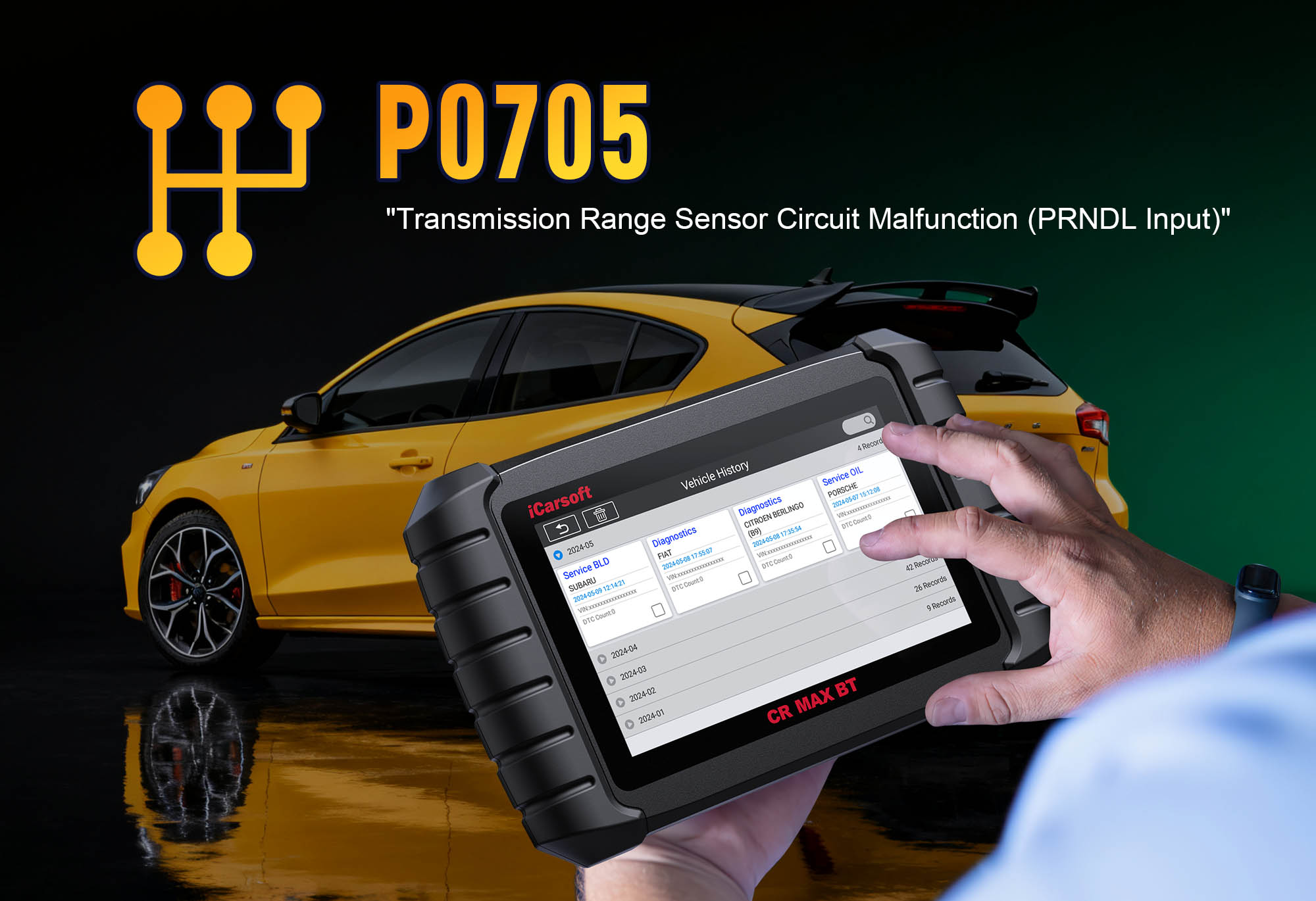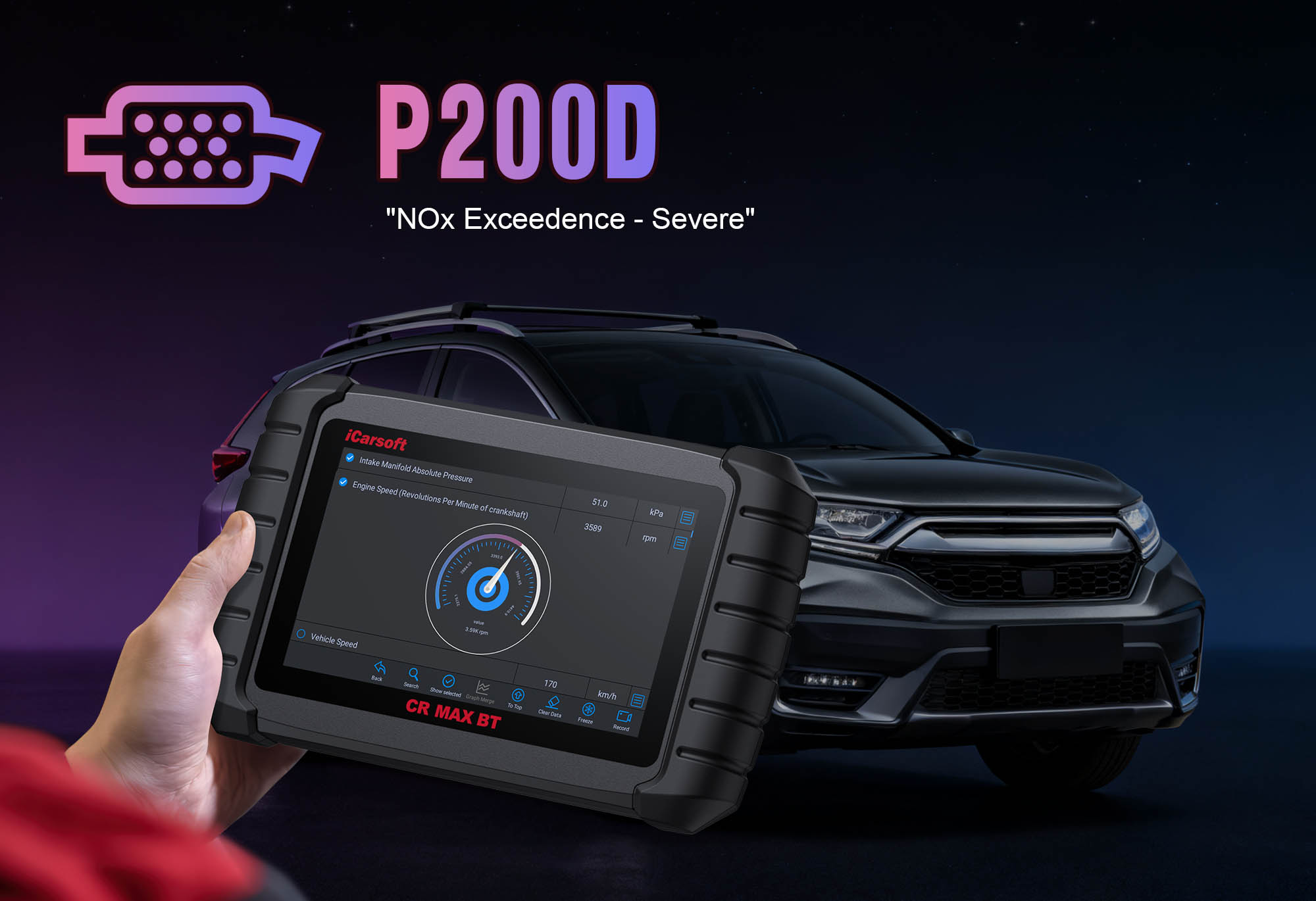Diagnose & Clear P0705 with iCarsoft CR MAX BT: Fix Transmission Range Sensor Circuit Malfunction
If your check engine light illuminates and a scan returns P0705, your vehicle’s transmission system is signaling a problem with the Transmission Range Sensor (TRS)—also known as the neutral safety switch. This OBD-II code stands for "Transmission Range Sensor Circuit Malfunction (PRNDL Input)"—indicating the Engine Control Module (ECM) or Transmission Control Module (TCM) has detected an abnormal voltage, no signal, or intermittent communication from the sensor that monitors gear selector position (Park, Reverse, Neutral, Drive, Low).
The TRS is critical for safe transmission operation: it tells the ECM/TCM which gear is selected, enabling safety features (e.g., preventing engine start in Drive/Reverse), activating reverse lights, and ensuring smooth shifting. When P0705 occurs, this communication breaks down—leading to starting failures, non-functional reverse lights, erratic shifting, or limp mode (limited speed/gears to avoid damage).
Basic scanners may only flag "range sensor fault" but can’t test circuit continuity or verify gear position signals. The iCarsoft CR MAX BT—with its wireless signal analysis, live gear monitoring, and component activation tools—solves this. Let’s explore how to diagnose and resolve P0705 using this advanced tool.
 iCarsoft CR MAX BT displaying live TRS gear position data, voltage readings, and TCM communication status for P0705 diagnosis
iCarsoft CR MAX BT displaying live TRS gear position data, voltage readings, and TCM communication status for P0705 diagnosis
Understanding P0705: Causes & Key Symptoms
A faulty TRS disrupts gear position communication, leading to distinct safety and performance issues:
Key Symptoms of P0705
-
Check Engine Light: Illuminates when the ECM/TCM detects no signal, erratic voltage, or a short/open TRS circuit for 2+ drive cycles.
-
Engine Starting Issues: Engine won’t start in Park/Neutral (safety interlock triggered by bad data) or starts in other gears (dangerous).
-
Reverse Lights Not Working: TRS fails to signal Reverse selection, leaving reverse lights inactive.
-
Erratic Shifting: Transmission shifts unexpectedly (e.g., jumps to Neutral) or stays stuck in one gear due to incorrect position data.
-
Limp Mode Activation: TCM limits vehicle to 2nd/3rd gear (30–40 mph max) to prevent transmission damage.
-
Gear Indicator Errors: Dashboard shows wrong gear (e.g., "Park" when in Drive) or flashes unpredictably.
Common Causes of P0705
|
Cause
|
Description
|
|
Faulty Transmission Range Sensor
|
Internal electrical failure (worn contacts, shorted circuits) prevents accurate gear signaling—accounts for ~45% of P0705 cases.
|
|
Damaged Wiring or Connector
|
Frayed wires, corroded terminals, or loose plugs disrupt signal flow between TRS and TCM/ECM—worsened by transmission heat.
|
|
Misadjusted TRS
|
Sensor out of alignment with gear selector linkage (common after transmission repairs or battery replacement) sends wrong gear data.
|
|
Dirty/Contaminated Sensor
|
Oil, dirt, or transmission fluid on TRS contacts (from leaks) interferes with signal transmission.
|
|
Broken Gear Selector Linkage
|
Bent/disconnected linkage prevents TRS from registering actual gear positions (e.g., selector in Reverse, but TRS stays in Neutral).
|
|
Failed TCM/ECM (Rare)
|
Faulty module misinterprets normal TRS data, usually paired with communication codes (e.g., U0101, U0102).
|
Why iCarsoft CR MAX BT Excels at Diagnosing P0705
The CR MAX BT outperforms basic tools with TRS-specific diagnostics to pinpoint P0705’s root cause:
Wireless Gear Position Monitoring
Streams real-time TRS data to your device, verifying if the sensor correctly registers Park/Reverse/Neutral/Drive selections.
Circuit Voltage Testing
Measures voltage at the TRS connector and wiring paths to identify shorts, opens, or low-power issues (e.g., 0V when 5V is expected).
Sensor Signal Analysis
Decodes TRS signal patterns, comparing them to manufacturer specs (e.g., 0.5V = Park, 2.5V = Reverse for analog sensors).
Bi-Directional Control
Sends commands to activate reverse lights or starter interlock, isolating TRS faults from component failures.
3D Component Diagrams
Preloaded schematics show TRS location (transmission case, linked to selector), wiring paths, and pinouts for 80+ makes (Ford, Chevrolet, Honda, BMW).
TCM/ECM Integration
Cross-references TCM data to rule out module communication issues (e.g., "No TCM Response" vs. TRS fault).
Step-by-Step: Diagnose P0705 with iCarsoft CR MAX BT
-
1. Connect & Confirm the Code
Plug the CR MAX BT into your vehicle’s OBD-II port and pair it with your smartphone/tablet via the iCarsoft app (Bluetooth setup: 30 seconds).
Select your vehicle using Auto VIN Scan (instant VIN read) or manual entry (make/model/year/transmission type: automatic CVT).
Navigate to Transmission > Fault Codes > Read Codes to confirm P0705. Tap Code Details for vehicle-specific insights (e.g., "Ford: TRS Signal = Erratic – No Valid Gear Detection").
-
2. Locate the Transmission Range Sensor
Use the CR MAX BT to avoid misidentification:
Go to Component Location > Transmission > Sensors > Transmission Range Sensor.
The app displays a 3D diagram: The TRS is typically mounted on the side of the transmission case, connected to the gear selector linkage, with a 6–10 wire connector. For front-wheel-drive vehicles, it may be near the shifter assembly.
-
3. Analyze Live Gear Position Data
The CR MAX BT’s real-time data reveals TRS miscommunication:
Turn the ignition to "On" (engine off) and move the gear selector through Park → Reverse → Neutral → Drive → Low (pause 2 seconds per gear).
In the app, go to Transmission > Live Data > Gear Position and monitor:
- "TRS Gear Position": Should match the selector (e.g., "P" = Park, "R" = Reverse). P0705 = incorrect/missing readings (e.g., "Neutral" in all positions).
- "TRS Voltage": Analog sensors show incremental steps (e.g., 0.5V = Park, 1.5V = Reverse, 2.5V = Neutral). Digital sensors show discrete values (e.g., "5" = Drive).
Note discrepancies: If the selector is in Reverse but the app shows Neutral, the TRS or linkage is faulty.
-
4. Inspect the Sensor, Connector & Linkage
Physical issues are often the cause—check with the CR MAX BT’s guidance:
Sensor Inspection:
Locate the TRS using the app’s diagram. Disconnect the connector and check for:
- Cracks in the sensor housing (from impact or overheating).
- Oil/transmission fluid contamination (sign of leaks—clean with brake cleaner if minor).
- Worn linkage contacts (visible wear on the sensor’s moving parts).
Connector Check:
Examine the plug for corrosion (white/green deposits), bent pins, or water intrusion. Clean terminals with electrical contact cleaner; straighten bent pins with needle-nose pliers.
Linkage Adjustment:
Use the app’s Linkage Alignment Guide (under Component Location > Transmission > Linkage) to verify alignment. Loosen the TRS’s mounting bolts and adjust until the app’s live data matches the selector position. Tighten bolts once aligned.
-
5. Test the TRS Circuit’s Electrical Function
Validate TRS and circuit health with the CR MAX BT:
Voltage Supply Test:
Turn the ignition to "On" (engine off). Use the app’s Multimeter Function to measure voltage at the TRS’s power pin (refer to the app’s TRS Pinout Guide). Normal = 5V or 12V (varies by vehicle). 0V = check TCM fuse (labeled "TCM" or "TRANS") or wiring to the TCM.
Ground Circuit Test:
Measure resistance between the TRS’s ground pin and a clean chassis point (e.g., battery negative). Normal = <1 ohm. >5 ohms = corroded ground—clean the ground strap or repair the wire.
Sensor Continuity Test:
Disconnect the TRS from the harness. Move the selector through gears while measuring continuity between specific pin pairs (use the app’s TRS Continuity Chart). Missing continuity (e.g., no signal in Reverse) = replace the sensor.
-
6. Diagnose Wiring for Shorts & Open Circuits
Damaged wires disrupt TRS signals—test with the CR MAX BT:
Short Circuit Test:
Navigate to Special Functions > Electrical Tests > Short Circuit Test.
Connect one test lead to the TRS’s signal wire (at the connector) and the other to ground. A reading <5 ohms = shorted wire—repair with heat-shrink butt connectors.
Continuity Test:
Check continuity between the TRS’s connector and the TCM (use the app’s wiring diagram). Resistance >1 ohm = broken wire—repair or replace the harness (pay attention to wires near hot exhaust components).
-
7. Verify TCM/ECM Communication
Rule out module issues with the CR MAX BT:
Navigate to Transmission > Module Information > TCM Status.
Check for errors like "No TCM Response" or "Communication Lost"—these indicate a TCM fault (not a TRS issue) and require professional module testing.
If TCM communication is normal (shows "Active" and module version), the problem lies with the TRS, wiring, or linkage.
-
8. Repair & Clear P0705
Fix the Root Cause (prioritize based on test results):
- Replace the TRS (use OEM parts—check the app’s Part Lookup for exact fit).
- Adjust/replace the gear selector linkage (follow the app’s alignment guide).
- Repair damaged wiring with heat-shrink connectors; replace severely corroded harnesses.
- Clean/replace the TRS connector; apply dielectric grease to prevent moisture damage.
Clear the Code: In the app, go to Transmission > Fault Codes > Clear Codes to delete P0705.
-
9. Validate the Repair
Confirm safe TRS and transmission operation:
- Recheck live data: Gear position readings must match the selector (e.g., "R" = Reverse, "D" = Drive).
- Test starting: Engine should start only in Park/Neutral; no start in Drive/Reverse.
- Verify reverse lights: Activate when selector is in Reverse.
- Test drive: Take a 15-minute drive (city/highway) to check for smooth shifting—no limp mode or erratic gear changes.
- Re-scan: Use the CR MAX BT to recheck codes—no P0705 recurrence = successful repair.
Preventing P0705 Recurrence
The CR MAX BT helps maintain reliable TRS performance long-term:
-
Sensor Maintenance: Use the app’s Service Reminder to inspect the TRS every 60,000 miles and replace it every 100,000–150,000 miles (sensors wear from linkage movement).
-
Linkage Adjustment: Check alignment annually, especially after transmission fluid changes or battery replacements (voltage drops can reset sensor position).
-
Connector Care: Apply dielectric grease to the TRS plug annually to repel moisture and corrosion.
-
Transmission Leak Checks: Inspect for fluid leaks (use the app’s Transmission Fluid Level Guide)—leaks damage TRS contacts.
-
Regular Scans: Use the CR MAX BT’s Quick Scan quarterly to catch early TRS signal irregularities (e.g., intermittent voltage drops).
Conclusion
P0705’s TRS malfunction threatens safety (e.g., starting in Drive) and transmission health, but the iCarsoft CR MAX BT simplifies diagnosis with wireless gear monitoring, circuit tests, and linkage guides. Unlike basic scanners, it distinguishes between sensor faults, wiring issues, and TCM problems—avoiding costly misrepairs (e.g., replacing a $200 TCM when the TRS needs adjustment).
Whether replacing a sensor, aligning linkage, or repairing wiring, the CR MAX BT ensures you resolve the root cause—restoring safe starting, shifting, and reverse light function. With this tool, tackling "transmission range sensor faults" becomes a precise, confident process.
FAQs About P0705 Code
Q: Can I drive my vehicle with P0705?
A: Not safely. P0705 can cause unexpected shifting, limp mode, or starting in gears like Reverse—risking accidents. If you must drive short distances (5 miles max), use Park/Neutral for starting and avoid high speeds. Fix it within 1–2 days.
Q: How much does it cost to fix P0705?
A: Costs vary by cause: TRS replacement = $80–$200 (DIY); linkage adjustment = $50–$150 (professional); wiring repair = $20–$60; TCM replacement = $500–$1,200 (rare). The CR MAX BT saves money by avoiding TCM misrepairs.
Q: Why does P0705 come back after replacing the TRS?
A: Common reasons: 1) Misaligned new sensor (didn’t follow the app’s linkage guide); 2) Unrepaired wiring short (still dropping voltage); 3) Hidden linkage damage (bent rod not replaced); 4) TCM fault (masked by TRS replacement). Re-run the CR MAX BT’s alignment and wiring tests.
Q: Is the transmission range sensor the same as the neutral safety switch?
A: Yes—they’re the same component. "Neutral safety switch" describes its safety function (preventing start in gear), while "transmission range sensor" describes its role in signaling gear position to the TCM. The CR MAX BT refers to it as TRS for consistency.
Q: Will a dead battery cause P0705?
A: A dead battery rarely causes P0705 directly, but jump-starting or battery replacement can misalign the TRS (voltage spikes reset sensor calibration). If P0705 appears after a battery service, use the CR MAX BT’s linkage alignment guide to realign the TRS before replacing parts.

 iCarsoft CR MAX BT displaying live TRS gear position data, voltage readings, and TCM communication status for P0705 diagnosis
iCarsoft CR MAX BT displaying live TRS gear position data, voltage readings, and TCM communication status for P0705 diagnosis



